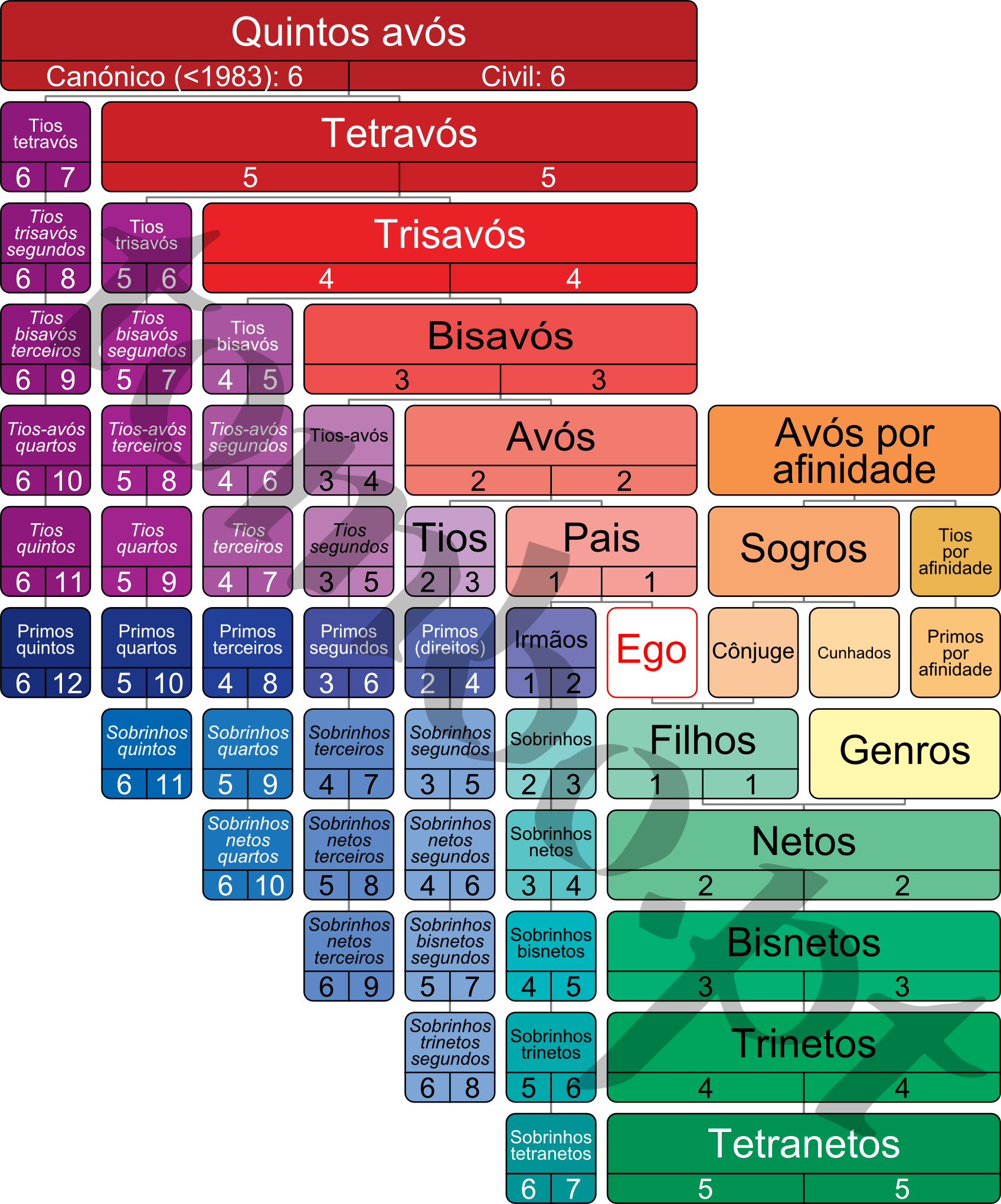[...] «the cousins of our cousins, our cousins are.»
Júlio Dinis, A Morgadinha dos Canaviais (1868)
Consanguinity degree calculation
Sooner or later, during your genealogical research in Portugal, you'll encounter the expression consanguinity in the nth degree, but what does this really mean? To answer that question, we need to distinguish between two legal systems: the germanic (used by the canon law until 1983) and the roman (used by the Portuguese civil law since 1867).
Germanic system - Canon Law
The consanguinity degrees usually found in genealogy are mentioned in marriage records. Parish records prior to 1983 use the Canon Law of the Catholic Church. This law, which went into effect in the 13th century, forbids any marriage between two persons with up to four degrees of consanguinity, except in case a dispensation is granted. In 1983, the Catholic Church adopted a new Canon Law, starting to use the same calculation method as the Civil Law, keeping the marriage impediment up to the 4th degree of consanguinity. The definition in the Canon Law of 1917 of canon 96 was:
- Consanguinitas computatur per lineas et gradus. - Consanguinity is calculated by lines and degrees.
- In linea recta, tot sunt gradus quot generationes, seu quot personae, stipite dempto.
In the direct line, there are as many degrees as there are generations, that is, persons, omitting the common ancestor.- In linea obliqua, si tractus uterque sit aequalis, tot sunt gradus quot generationes in uno tractu lineae: si duo tractus sint inaequales, tot gradus quot generationes in tractu longiore.
In the collateral line, if treating of cases of equal length, there are as many degrees as there are generations in one line; if treating of unequal cases, there are as many degrees as there are generations in the longer line.
To calculate the canonic degree between two individuals, you simply count the number of individuals until the common ancestor in the longer branch (see in the figure the number at bottom left).
Using this method, the marriage with a second cousin would have the 3rd degree of consanguinity, the same as with a great uncle, since the common ancestor is the same (the great grandparent).
Roman system - Civil Law
Roman law already forbade marriages up to the 4th degree of consanguinity. This method of calculation was inserted in Portuguese law with the Civil Law of 1867, in its articles 1973 to 1977. The current Civil Law defines the calculation of degrees of kinship in its Article 1581, unchanged since the Civil Law of 1966:
- Na linha recta há tantos graus quantas as pessoas que formam a linha de parentesco, excluindo o progenitor. [In the straight line, there are as many degrees as there are individuals who form the kinship line, excluding the ancestor.]
- Na linha colateral os graus contam-se pela mesma forma, subindo por um dos ramos e descendo pelo outro, mas sem contar o progenitor comum. [In the collateral line the degrees are calculated the same way, climbing one of the branches and descending the other, without counting the common ancestor.]
In practice, the roman system counts the number of relatives between the two persons in both kinship branches minus one (see in the figure the number at bottom right).
Using this method, the marriage with a second cousin would have the 6th degree of consanguinity.

Kinship Terminology
In the figure, it is presented also the common term for the degrees of relationship, being that the Portuguese language is missing an authoritative definition of the correct terms for the chidren of the great-n-uncles (purple section) and the children of the cousins (blue section). There are currently two terminology systems for these cases:
Uncles-nephews
This system, used in the German and Spanish languages, is characterised by the restricted use of the term cousin, which is only used to designate the grandsons of the same grandparents (first cousins), the great-grandsons of the same great-grandparents (second cousins), etc. The term uncle is applied to the ancestors of the cousins, and the term nephew to their descendants. In this system (show in the figure above), the son of the great uncle is the second uncle, and the son of the first cousin is the second nephew. This system allows the objective identification of relationships and does not create any confusion between distinct relationships.
Removed cousins
In the English and French languages, these relationships use the term 'removed', classifying them by degree of removal. Thus, the son of a great uncle is a first cousin once removed, the same as a son of the first cousin. The father of a third cousin is a second cousin once removed (same as the son of a second cousin), while his son is a third cousin once removed. Since there are different types of relationships sharing the same designation, this system does not allow a clear identification, and can lead to some confusion.
Note that both systems can coexist, and a second uncle can also be known as first cousin once removed. Until the day when several reference dictionaries in the Portuguese Language start to use the same definition for second uncle, or in alternative, for first cousin once removed, it's not possible to state which of the alternatives is the right one.